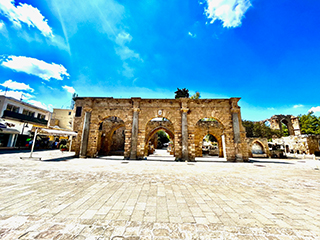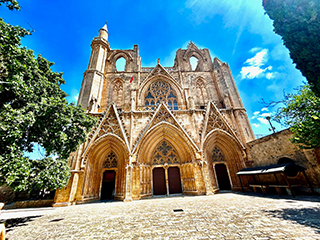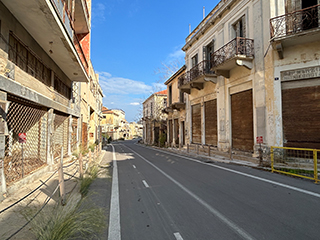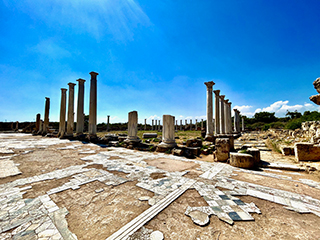Famagusta Cyprus- explore the walled city of Cyprus with a private guide
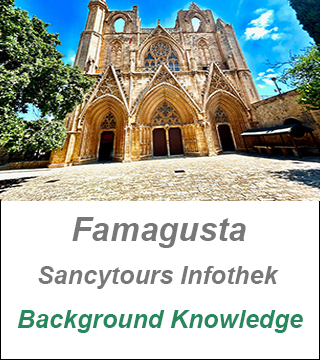 The city Famagusta Cyprus was founded around 274 BC by Ptolemy II after Salamis had been severely damaged by an earthquake. Arsinoe was described in the first century BC by Strabon in his Geographica as a „fishing town“. It remained a small fishing village for a long time. Later, when Salamis was gradually cleared during the Arab invasion under Muawiyah I, it developed into a small port.
The city Famagusta Cyprus was founded around 274 BC by Ptolemy II after Salamis had been severely damaged by an earthquake. Arsinoe was described in the first century BC by Strabon in his Geographica as a „fishing town“. It remained a small fishing village for a long time. Later, when Salamis was gradually cleared during the Arab invasion under Muawiyah I, it developed into a small port.
The turning point for Famagusta Cyprus from a small village to a town came in 1192 with the onset of Lusignan rule. It was during this period that Famagusta Cyprus developed into a fully fledged town. It became increasingly important in the Eastern Mediterranean because of its natural harbour and the walls that protected its inner city. Its population began to grow.
Famagusta Cyprus is one of the island’s most historically layered cities
This development accelerated in the 13th century when the city became a trading centre for both the East and the West. An influx of Christian refugees fleeing the fall of Acre (1291) in Palestine transformed it from a tiny village into one of the richest cities in Christendom.
In 1372 the port was conquered by Genoa and in 1489 by Venice. These trading activities made Famagusta Cyprus a place where merchants and ship owners lived a life of luxury. By the mid-14th century, Famagusta Cyprus is said to have had the richest citizens in the world. The belief that people’s wealth could be measured by the churches they built prompted the merchants to have churches built in various styles. These churches, which still exist today, have earned Famagusta Cyprus the nickname „City of 365 Churches“ (one for every day). The development of Famagusta Cyprus focused on the social life of the rich and on the Lusignan Palace, the Cathedral, the main square and the port.
In 1570-1571, Famagusta Cyprus was the last fortress in Venetian Cyprus to resist the Turks under Mustafa Pasha. The city withstood a 13-month siege and devastating bombardment before finally surrendering. The Ottoman forces had lost more than 50,000 men, including Mustafa Pasha’s son. Although the terms of the surrender allowed the Venetian troops to return home, the Venetian commander Marco Antonio Bragadin was skinned alive, his lieutenant Tiepolo hanged and many other Christians killed.
With the time of Ottoman rule, Christians in Famagusta Cyprus lost their privileged status and were eventually expelled from the city. Greek Cypriots were initially allowed to purchase property in the city, but were evicted from the fortified city in 1573-74 and had to settle outside in the area that later became Varosha.
Turkish families from Anatolia settled in the fortified city, but not in such large numbers that all the houses could be used by the new inhabitants, as the city had previously had more than 10,000 inhabitants. This led to a drastic decline in the population of Famagusta Cyprus, and the merchants of Famagusta, most of whom were displaced Latins, settled in Larnaka. Larnaka flourished while Famagusta lost its importance as a trading centre. Over time, Varosha developed into a thriving agricultural town, thanks to its location away from the marshes, while the fortress city fell into disrepair.
In the fortified city, some buildings were adapted for the needs of the Muslim population. „St Nicholas“ Cathedral was converted into a mosque (Lala Mustafa Pasha Mosque), a bazaar was established, public baths, fountains and a theological school were built. The cul-de-sacs typical of Ottoman towns were introduced into the city and a sense of community developed, with a small number of two-storey houses inhabited by the small upper class coexisting with the widespread one-storey houses.
With the British takeover, Famagusta regained its importance as a port and economic centre, and the development of the city was explicitly included in the British plans. Immediately after the British took over the island, a Famagusta Development Act was passed, which provided for the reconstruction and rehabilitation of the city’s dilapidated streets and buildings, as well as the improvement of sanitary conditions. At the end of British rule, new residential areas were built for the growing population, and by 1960 Famagusta was a modern port city that extended well beyond Varosha and the walled town.
From Cyprus‘ independence in 1960 until the Turkish invasion in 1974, Famagusta Cyprus, located southwest of Varosha, developed into a tourist centre. In the late 1960s, Famagusta Cyprus became a well-known entertainment and tourism centre.
During the Turkish invasion of Cyprus in 1974, the Mesaoria plain was overrun by Turkish tanks and Famagusta Cyprus was bombed by Turkish planes. It took the Turkish army two days to capture the city. Before that, the entire Greek Cypriot population of Famagusta Cyprus had fled to the surrounding fields. As a result of the Turkish air strikes, dozens of civilians died, including tourists.
Unlike other parts of Turkish-controlled areas of Cyprus, the Varosha suburb of Famagusta Cyprus was sealed off by the Turkish army immediately after the conquest and remained sealed off until October 2020, when the Turkish Republic of Cyprus reopened some roads to visitors. Some Greek Cypriots who had fled Varosha were allowed to visit the town and journalists were given access.
Shortcuts
- The Lala Mustafa Pasha Mosque, originally the St. Nicholas Cathedral, is the largest medieval building in Famagusta Cyprus.It was built between 1298 and about 1400 and consecrated as a Catholic cathedral in 1328.
After the Ottoman Empire conquered Famagusta Cyprus in 1571, the cathedral was converted into a mosque and remains a mosque to this day.
- The Palazzo del Provveditore, also called the Venetian Palace, was the royal palace of Famagusta Cyprus, originally built by the Lusignan kings of Cyprus.
It was later rebuilt and used as the official residence of the governor during Venetian rule.
The central part of the palace was completely destroyed, so that only the large façade and the rear courtyard walls remain.
The chroniclers Leontios Machairas and Diomede Strambaldi write that the church was built around 1360 by the Lachas brothers. These brothers were two „East Syrian“, i.e. Nestorian merchants known for their great wealth. The chroniclers highlighted the building’s architecture and decorations, which were reminiscent of the Gothic churches of southern France and Italy of the time, and hypothesised that King Peter I’s visit to Avignon in 1363 might have influenced its construction.
- The Namık Kemal Dungeon (Turkish: Namık Kemal Zindanı) is a historic building in Famagusta Cyprus, known for being the home of the influential Turkish writer Namık Kemal between 1873 and 1876.
The building was originally part of the Palazzo del Provveditore (Venetian Palace) and was built in its present form during the Ottoman period. The building consists of two floors, with the lower floor having pre-Ottoman architecture and the upper floor being clearly Ottoman. Archaeologist Tuncer Bağışkan identified the pre-Ottoman style as Lusignan. The building is L-shaped and while the lower floor is made of ashlars, the upper floor was built using the Baghdadi technique.
- The Franciscan church was originally part of a Franciscan monastery and stood next to the royal palace. The outer walls were supported by buttresses. It was built in the middle of the sixteenth century with the financial support of Henry II, King of Cyprus, who ruled from 1285 to 1324.
Henry’s reign was anything but peaceful. He experienced the fall of Acre in 1291, his own imprisonment from 1306 to 1310 and the dissolution of the Knights Templar in 1313. Nevertheless, in the last years of his reign, he financed not only the construction of this church, but also the fortification of Famagusta Cyprus and the beginning of the reconstruction of St. Nicholas Cathedral.
- St. George’s Church is one of the oldest churches in Famagusta Cyprus. The exact date of construction is not known, but evidence of a crenellated parapet used by the defenders to protect the church suggests that it was built at a time when the Lusignans had not yet completed the city walls. The ground plan of the church was probably inspired by the church of St. Chapelle in Paris, built in 1241. It is generally believed that the church was built in the last quarter of the 13th century using material from the ruins of Salamis.
Visit Famagusta Cyprus with Sancytours
Famagusta Cyprus is a city of powerful history and contrasts, and it can be explored privately with SancyTours — perfectly combined with visits to the ancient city of Salamis or the ghost town of Varosha; we recommend booking early to secure your personalised experience.
Nowhere else in Cyprus do so many eras meet so closely as in Famagusta Cyprus. Behind massive Venetian walls lies a city shaped by crusaders, merchants, and empires.
During your Private Famagusta Cyprus Tour your guide will tailor the tour to your interests — whether you want to focus on ancient history, modern stories, or the cultural contrasts of the island’s divided capital.
Discover the charm, mystery, and emotion of North Cyprus on this Private Famagusta Cyprus Tour, where every stone tells a story and every stop reveals another layer of the island’s fascinating past.
Each Private Famagusta Cyprus Tour option offers a different glimpse into the island’s layered past, where beauty and history intertwine.
Choose your date and book now:
| M | D | M | D | F | S | S | |
|---|---|---|---|---|---|---|---|
49 | 1 | 2 | 3 | 4 | 5 | 6 | 7 |
50 | 8 | 9 | 10 | 11 | 12 | 13 | 14 |
51 | 15 | 16 | 17 | 18 | 19 | 20 | 21 |
52 | 22 | 23 | 24 | 25 | 26 | 27 | 28 |
01 | 29 | 30 | 31 |
| M | D | M | D | F | S | S | |
|---|---|---|---|---|---|---|---|
01 | 1 | 2 | 3 | 4 | |||
02 | 5 | 6 | 7 | 8 | 9 | 10 | 11 |
03 | 12 | 13 | 14 | 15 | 16 | 17 | 18 |
04 | 19 | 20 | 21 | 22 | 23 | 24 | 25 |
05 | 26 | 27 | 28 | 29 | 30 | 31 |
Author: Jürgen Derichs am 5. März 2024 13:26, category: Infothek Cities and Villages, comments per feed RSS 2.0, comments closed.











